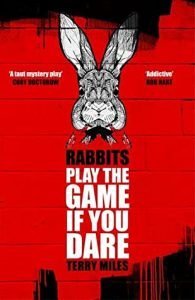Adrian Collins's Blog, page 172
June 11, 2021
REVIEW: Deadlands – The Weird West
Deadlands: The Weird West is a roleplaying game that ranks up there with Vampire: The Masquerade and Call of Cthulu as my all-time favorites. Coincidentally, those are some of the darkest and most grimdark of games. Deadlands could be played as gonzo and bizarre but also horrifying or mysterious. It managed to survive for 25 years in print in times both feast or famine in the RPG industry and the newest edition was something that I was eager to plow into. Much to my surprise, the game line and setting have undergone massive changes since the last time I have played it. Some of them controversial and others unquestionably for the better.
 The premise is that the Civil War lasted far longer due to the secret manipulations of supernatural forces that resulted in a zombie plague at Gettysburg among other events. The Wild West has now been afflicted with hordes of monsters and the player characters are among the only cowpokes capable of stopping them as well as the Servitors of the Four Horsemen-like Reckoners. The game incorporates elements of steampunk, supernatural horror, and all variations of Wild West storytelling from John Ford to Spaghetti Western.
The premise is that the Civil War lasted far longer due to the secret manipulations of supernatural forces that resulted in a zombie plague at Gettysburg among other events. The Wild West has now been afflicted with hordes of monsters and the player characters are among the only cowpokes capable of stopping them as well as the Servitors of the Four Horsemen-like Reckoners. The game incorporates elements of steampunk, supernatural horror, and all variations of Wild West storytelling from John Ford to Spaghetti Western.
Deadlands moved to the Savage Worlds system with their Reloaded edition. This was a controversial move, changing the entire game system of an already popular game, but has worked out well in keeping the Deadlands brand alive. After a highly successful Kickstarter, the Deadlands: The Weird West (Savage Worlds Adventure Edition) was released with a dramatically different setting as well as an updated set of rules.
The biggest change of the setting is that the socio-political structure of the campaign world is completely upended. In the original and Reloaded versions of Deadlands, the Confederacy effectively won the Civil War and entered into a Cold War with the Union. This proved controversial with fans since, zombie uprising or not, the Confederacy winning the war was incredibly unlikely when faced with the industrialized North. It also won by liberating slaves and ending the practice of slavery that the CSA was founded to preserve. As I stated elsewhere in history classes I’ve taught, “The states rights the CSA was founded to preserve were slavery and its practices. It’s in their declaration of independence.”
 Personally, I think this is a wise decision as immersion in an alternate history game depends on the plausibility of the events involved. I can believe in armies of zombies and monster hunting cowboys but I can’t believe that Jefferson Davis would ever end slavery save at the end of a surrender agreement. It also preserves the motivations of numerous historical figures. Jesse James is a bank robber and unreconstructed Confederate because the CSA lost. Plenty of the migration to the Wild West is also driven by blacks fleeing former slave states to new territories.
Personally, I think this is a wise decision as immersion in an alternate history game depends on the plausibility of the events involved. I can believe in armies of zombies and monster hunting cowboys but I can’t believe that Jefferson Davis would ever end slavery save at the end of a surrender agreement. It also preserves the motivations of numerous historical figures. Jesse James is a bank robber and unreconstructed Confederate because the CSA lost. Plenty of the migration to the Wild West is also driven by blacks fleeing former slave states to new territories.
The Adventure Edition doesn’t dwell much on the Civil War aspect but actually has a large amount of detail regarding the metaplot of previous editions, particularly the Fall of the Servitors. Honestly, I feel like this is a bit indulgent and would have preferred more information on the politics of the present day. There is, however, lots of information on locations throughout the setting so that Storytellers will not be starved for campaign information. The focus is now less on metaplot now and more like Wild West horror and local adventures.
The Savage World rules are fast and entertaining with a focus on replicating cinematic Wild West action pieces. It’s very hard to die in the game as a player character and will usually require something dramatic to happen first. You can be anything from a gunslinging saloon girl to an undead mad scientist and everything in-between. The art is fantastic and it’s a distinctly memorable setting. I think now is probably the best time to start playing it.
Play Deadlands: The Weird West
The post REVIEW: Deadlands – The Weird West appeared first on Grimdark Magazine.
June 10, 2021
Artist spotlight: Carlos Diaz
When Carlos Diaz responded to our last cover artist open window after the departure of Jason Deem, his was one of the first submission emails I opened, and he was shortlisted immediately. His dark, moody style was an absolutely perfect match for what I was after to represent our magazine to the readership. You can head over to our catalogue to the work he’s done for GdM.
Check out more of Carlos Diaz artwork over on his ArtStation here. You can reach out to him through his website for commission work, here.
Welcome AppetizerOne of Carlos’ personal works. I’m not sure if this magnificent piece is siting on somebody’s cover as a stock art piece, but if it isn’t, it needs to be ASAP. The movement, armour style, and the heat coming off the page are just brilliant.

I haven’t played the RPG, but damn this would make an amazing character / beast card. If you come across this chain demon, you know you’re in for one hell of a fight.

I love how much this artwork says without a singe word attached. Undead horsemen, barbarians, axes with faces, all in Carlos’ dark AF style.

In another personal work, Carlos switches up to a science fiction style work. Once more, the mood and atmosphere is there in absolute spades, and once again, I can’t believe I haven’t seen this on an indie cover somewhere.

This work just looks amazing to me. Once again dark and moody, but also encapsulating what dark elves are all about. From D&D to Mordheim, this is how they look in my mind’s eye.

Another personal work from Carlos. Just dead set shit your pants scary.
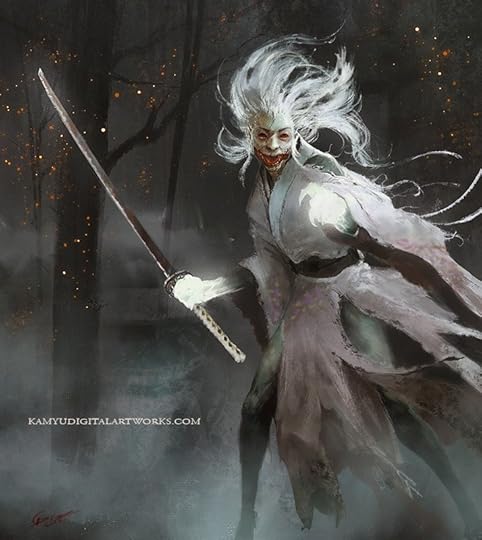
The post Artist spotlight: Carlos Diaz appeared first on Grimdark Magazine.
June 9, 2021
REVIEW: The Girl and the Mountain by Mark Lawrence
I received a review copy of The Girl and the Mountain from the author in exchange for an honest review. Thank you to Mark Lawrence and Ace Books.
The Girl and the Mountain continues the action after the enormous cliffhanger that ended The Girl and the Stars. What could possibly occur next has often plagued my thoughts for almost a year and a half. To be truthful, apart from the knockout of a finale, my memories of the previous novel are hazy which is why I applaud Lawrence for including a The Story So Far section. When I was caught up and was content that I didn’t need a reread of the first book, I was excited to continue with The Book of the Ice, and was hopeful that I’d enjoy it as much as I did The Girl and the Stars.
 This is the ninth of Lawrence’s novels that I have read, and if my memory serves me correctly, it is the first time he has written multiple point-of-view perspectives. Yaz is still the titular Girl and the main protagonist. She’s influential, likeable and extremely powerful as she can wield the power of the stars and touch the river that runs through all things. The two other point of view characters readers will be familiar with from the first novel and they both care deeply for Yaz in their own unique ways. For the first 50% of The Girl and the Mountain, the three protagonists are all having adventures in or around the Mountain, which is known as the Black Rock, where the priests who keep order on the Ice reside. The three storylines come to a head in spectacular fashion at about the 50% mark with an expertly composed climax and set up for what comes next. This was deftly written so that The Girl and the Mountain has a halfway mark that many other authors would thrive to achieve at the end of a novel or even a series.
This is the ninth of Lawrence’s novels that I have read, and if my memory serves me correctly, it is the first time he has written multiple point-of-view perspectives. Yaz is still the titular Girl and the main protagonist. She’s influential, likeable and extremely powerful as she can wield the power of the stars and touch the river that runs through all things. The two other point of view characters readers will be familiar with from the first novel and they both care deeply for Yaz in their own unique ways. For the first 50% of The Girl and the Mountain, the three protagonists are all having adventures in or around the Mountain, which is known as the Black Rock, where the priests who keep order on the Ice reside. The three storylines come to a head in spectacular fashion at about the 50% mark with an expertly composed climax and set up for what comes next. This was deftly written so that The Girl and the Mountain has a halfway mark that many other authors would thrive to achieve at the end of a novel or even a series.
I won’t go into the exact details of what happens either before or after the 50% point yet, much like its predecessor, The Girl and the Mountain is a finely crafted mix of dark fantasy and science fiction with mysterious advanced technology, made by the previous occupants of this dystopian, dying planet. We find out further information about the Missing, the Gods worshipped on the Ice, and the many players behind the scenes, and what their goals are and could mean for Abeth. The harsh elements and realities on the Ice almost felt like a character or a villain in itself, to be respected and feared equally.
“Starvation is a much swifter process when you’re cold, but nobody dies truly thin on the ice. Starvation simply opens a gate for the wind to come through. It’s the wind that wields the knife.”
Lawrence’s writing often plays at the heartstrings, with the words, patterns, and emotions overtaking and overwhelming the reader like the winds on the Ice. I read a lot of fantasy, however, quite often when reading Lawrence, I have to put the book down, take a breath, reflect, and then continue, nodding to myself that this author really knows how to tell a great story.
 There is a lot to really enjoy in The Girl and the Mountain including many fine characters who we get to know far better in this entry, some intense and thrilling action segments, interesting and unique world history and technology with some neat crosses over with (potentially) our world as well as the world of The Book of the Ancestor. There are a few Easter Eggs for fans of Nona’s story and we’re given an idea of when this series takes place in relation to the previous trilogy. The Girl and the Mountain even includes a loyal, mechanical dog-like companion named Zox!
There is a lot to really enjoy in The Girl and the Mountain including many fine characters who we get to know far better in this entry, some intense and thrilling action segments, interesting and unique world history and technology with some neat crosses over with (potentially) our world as well as the world of The Book of the Ancestor. There are a few Easter Eggs for fans of Nona’s story and we’re given an idea of when this series takes place in relation to the previous trilogy. The Girl and the Mountain even includes a loyal, mechanical dog-like companion named Zox!
If I had to be extremely critical, 5-10% of the second half of this novel dragged and seems a bit repetitive, but, when analysing, I can’t really see this as a negative because I don’t know how Lawrence could have filled the pages differently to get from the already-mentioned, excellent halfway point, to the almost as fulfilling and well-worked conclusion. If the cliffhanger ending of the first novel “knocked you for six” then you’ll be curious to discover that The Girl and the Mountain also has a monster cliffhanger, just when things seem to be looking positive too.
With any other author, having to wait for the next novel on such a cliffhanger playing on your mind might be unbearable, but with Lawrence and his work rate, I’m certain the follow-up will be released next year. Book of the Ice is an excellent and artful merger of fantasy and science fiction by an author who knows how to make us care about his characters, many of whom may not make it to the final page. Even those who do make it that far, their safety is not assured and danger always seems to be lurking close, which is one of the reasons why I will pick up the as yet untitled 3rd book in the series as soon as I can.
Additional note: I listened to about a third of The Girl and the Stars by Audiobook. Helen Duff gives a fine performance and I particularly liked her Scouse-sounding accent for Yaz.
Read The Girl and the Mountain by Mark Lawrence
The post REVIEW: The Girl and the Mountain by Mark Lawrence appeared first on Grimdark Magazine.
June 8, 2021
REVIEW: 3:33 AM by Luke Hindmarsh
3:33 AM by Luke Hindmarsh is an occult horror novel that I picked up immediately upon release. I was a big fan of Mercury’s Son by the same author, so I was interested in seeing what he would come up with next. I was surprised that it wasn’t a science fiction novel like the previous one and even more eager to see what it would be like.
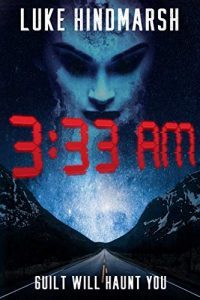 Grimdark fans should note that this is an excellent example of its genre and will come strongly recommended. So much so that I recommend you read it without finishing this review. Go in entirely fresh and enjoy it without any spoilers. However, if you need more information to make your purchase then please carry on.
Grimdark fans should note that this is an excellent example of its genre and will come strongly recommended. So much so that I recommend you read it without finishing this review. Go in entirely fresh and enjoy it without any spoilers. However, if you need more information to make your purchase then please carry on.
The premise is that Saffron is a nurse that is overworked and barely able to stay awake when she accidentally plows into a couple of other cars. This results in the death of musician Jack’s brother Eddie as well as a number of their bandmates. Saffron not only escapes unharmed but she doesn’t receive any blame for the accident. Jack is traumatized and attempts to find some comfort in religion, which is difficult because he’s a rather casual atheist. Both of them are haunted by strange dreams and a shared mysterious figure that draws them together.
This book is very much a slow burn as we start with the two likable but flawed leads as their lives slowly unravel under the pressure of an unseen supernatural force. It reminds me a bit of Paranormal Activity, the original, where the central conceit is that the couple doesn’t take the horror seriously until it is too late to do anything about it. Something similar happens here as they seek answers among New Age spiritualism and pop psychology only to find themselves dealing with something infinitely worse.
H.P. Lovecraft and Stephen King both stated that the best way to make sure a horror story is genuinely scary is to not follow coherent rules. If you define a vampire then you know how to slay it. Here, the monster operates on its own sort of rules that are never clear to our heroes. They can’t get their bearings and it’s only at the end that we get any sort of clear answer and even that is open to interpretation.
Weirdly, I think my favorite part of 3:33 AM is the romance that develops between Saffron and Jack. This is because it’s a train wreck that we know is going to happen and there’s no way it can end well. Saffron is responsible for the death of Jack’s brother and begins a relationship with him under false pretenses. It’s all a twisted attempt to salve her own guilt, compounding her sin, and that’s what makes it interesting.
In conclusion, this is a solid and well-written horror novel. If you like genuine scares then I think this is worthwhile to read. I preferred Mercury’s Son and would be interested in Luke Hindmarsh revisiting that world but if he chooses to be a horror author from now on after this then this is a good sign of things to come.
Read 3:33 AM by Luke Hindmarsh
The post REVIEW: 3:33 AM by Luke Hindmarsh appeared first on Grimdark Magazine.
June 7, 2021
An Interview with Terry Miles, Author of Rabbits
Undoubtedly, if you are into podcasts as a long-form of storytelling you know of Terry Miles and by extension Tanis, and Minnow Beats Whale. Miles is a writer, producer, and director of multiple podcast mysteries. Terry’s shows are so real that sometimes it is difficult to tell the difference between fact and fiction. He utilizes sound effects, and historical notes, and pictures to set the scene and tell you a mystery in bite-sized podcast chunks. It is an addicting thing to listen to.
Now, Terry has taken one of his stories and put it into a new medium that of a novel, Rabbits. The first question I asked when I started this book was, “What is Rabbits?” The response was, “You don’t talk about Rabbits.” With that, the book sucked me in. Terry was kind enough to interview with us on his life, reading, writing, and Rabbits.
GdM: Your bio quoted that you have lived in “Moose Jaw, Saskatchewan, raised in the plains beneath the foothills of the Rocky Mountains, and forged by rain in the deep emerald gloom of the Pacific Northwest.” How have these places affected you?
The plains and prairies of Alberta left me with a longing for flat horizons and huge skies, but it was the temperate rainforest along the West coast that eventually fashioned my love of the dusky kind of darkness that seems to continually inform my writing. Ever since I was a kid, I’ve been drawn to dark cinema and literature, and I feel like living in the Pacific Northwest (or because I’m from Canada, perhaps the Pacific Southwest?) was the first time I actually felt a physical embodiment of that type of darkness.
 GdM: You are an individual of multiple talents. You write, direct, and produce. How is the creative process different from writing a book than producing a podcast, or directing a movie?
GdM: You are an individual of multiple talents. You write, direct, and produce. How is the creative process different from writing a book than producing a podcast, or directing a movie?
I actually started writing fiction. I went to school for Creative Writing (BFA, MFA from the University of British Columbia), and we were made to choose three genres. Mine were fiction, screen and stage. While I was there I made a movie that got into the Toronto International Film Festival, so that took me away from fiction for a while.
In my experience, when writing for different mediums, it’s important to lean into what each medium does best, dialogue, visuals, descriptive language, etc…although, to be honest, I never think about any of this stuff while I’m working. I feel like, if you want to write something, you really need to be a fan of that medium, and obsessively devour everything you can.
GdM: Tell me about The Public Radio Alliance and Minnow Beats Whale. How did they come about?
During Serial (Podcast)’s run, I came to the conclusion that it was unlikely a documentary podcast would be able to do that again. So, I decided I was going to make a “fake Serial.” I was tired of doing everything myself, so I talked a friend of mine I’d written a script with in the past into helping me co-write the series. I would take care of all the production stuff, mixing, music, etc…and recruit two friends of mine to play the narrator and the skeptic. This would become The Black Tapes Podcast, the first “fake Serial.” Six months to a year after we released The Black Tapes, the world of podcasting was flooded with things like Limetown, The Message and more. It’s been really exciting to watch the podcast space grow so quickly.
GdM: The reporting and stories coming out of Pacific Northwest Stories and Minnow Beats Whale are meticulously well researched and thorough. Have you had any listeners take everything for truth, as the 1938 War of the Worlds scripted drama?
Every single day we receive questions about the veracity of Tanis or Rabbits.
GdM: Tell me about ARGs. Where did the inspiration for this kind of storytelling come about, and how has it influenced you? You mention The Magus, Choose Your Own Adventure Books, Mass Affect, and many more on the podcast.
I’ve always been interested in stories that blend into and merge with real life. All I’ve ever wanted was the chance to take part in a genuine treasure hunt kind of mystery, a journey through the wardrobe, so to speak.
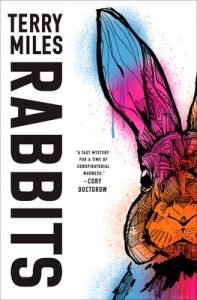 GdM: You have a way of creating stories with an addicting quality to them? What do you believe drives someone to come back to a story or conspiracy looking for more?
GdM: You have a way of creating stories with an addicting quality to them? What do you believe drives someone to come back to a story or conspiracy looking for more?
I feel like the best stories, like the best albums, have a quality of timelessness that lets you fold back into them again and again, either discovering something you hadn’t noticed before or reveling in the familiarity of certain moments and phrases. Something I try to do (and I have no idea if I’m successful or not), is attempt to construct a world that feels like it’s just one small section of something much bigger like there are interesting secrets and characters still waiting to be discovered outside the novel or podcast or film, etc…
GdM: Is there an internet story, conspiracy, or creepypasta that scared or creeped you out? For me, it has been 20 years since Ted the Caver, and it still creeps me out.
There are so many, but the Dionaea House by Eric Heisserer was by far my favorite.
GdM: What is Rabbits?
It’s a name given to a nameless game that, allegedly, exists.
GdM: How would you describe Rabbits to a new reader?
I would say that it’s my attempt to describe a mystery that I’ve been obsessed with for a very long time.
GdM: Rabbits has a strong element of mystery to it. Were you influenced by mystery stories growing up? And if so, which ones?
I didn’t read mystery stories growing up, but I read a lot, every single day. Early on it was stuff like Fritz Leiber, Michael Moorcock, Frank Herbert, Stephen King, the Middle Earth, and Narnia books, then it was all literary fiction: Amy Hempel, Richard Yates, Ford, all the Richards.
GdM: Can you tell me a bit about the rules of Rabbits?
From what I’ve been able to piece together, the biggest (and perhaps only) rule of Rabbits is, you don’t talk about Rabbits.
K is the protagonist of the book. We experience the world of Rabbits through K’s eyes.
GdM: Rabbits talks a lot about collective obsession, specifically when it comes to games. Did you do a lot of research on this? It seems like a deep, pardon the pun, rabbit hole to go down.
I did a lot of research into obsession, but sadly, most of the obsessive behavior, at least as far as gaming goes, comes from first-hand experience. When I was a kid, I was pretty obsessed with games and gaming (along with books and music).
GdM: What is next for you? Do you have plans to do adaptions of your other serial podcasts?
I’m currently working on the next book, and a whole bunch of podcast stuff. I’ve never really thought about the Rabbits novel as an adaptation, but I suppose it is, technically? I didn’t really think about the podcast before or during the writing of the book, although, of course, it does share the name. The book and the podcast are completely separate stories and, although they might exist in the same universe (and they might not), there is little to no overlap. I’ve sold all of the podcasts for television (some more than once), but have yet to get any of them greenlit to series. Hopefully soon!
Thank you for interviewing with me! This was so fun to read and get into.
Thank you for having me! I really enjoy talking about books!
Read Rabbits by Terry Miles
The post An Interview with Terry Miles, Author of Rabbits appeared first on Grimdark Magazine.
Interview With Terry Miles, Author of Rabbits
Undoubtedly, if you are into podcasts as a long-form of storytelling you know of Terry Miles and by extension Tanis, and Minnow Beats Whale. Miles is a writer, producer, and director of multiple podcast mysteries. Terry’s shows are so real that sometimes it is difficult to tell the difference between fact and fiction. He utilizes sound effects, and historical notes, and pictures to set the scene and tell you a mystery in bite-sized podcast chunks. It is an addicting thing to listen to.
Now, Terry has taken one of his stories and put it into a new medium that of a novel, Rabbits. The first question I asked when I started this book was, “What is Rabbits?” The response was, “You don’t talk about Rabbits.” With that, the book sucked me in. Terry was kind enough to interview with us on his life, reading, writing, and Rabbits.
GdM: Your bio quoted that you have lived in “Moose Jaw, Saskatchewan, raised in the plains beneath the foothills of the Rocky Mountains, and forged by rain in the deep emerald gloom of the Pacific Northwest.” How have these places affected you?
The plains and prairies of Alberta left me with a longing for flat horizons and huge skies, but it was the temperate rainforest along the West coast that eventually fashioned my love of the dusky kind of darkness that seems to continually inform my writing. Ever since I was a kid, I’ve been drawn to dark cinema and literature, and I feel like living in the Pacific Northwest (or because I’m from Canada, perhaps the Pacific Southwest?) was the first time I actually felt a physical embodiment of that type of darkness.
 GdM: You are an individual of multiple talents. You write, direct, and produce. How is the creative process different from writing a book than producing a podcast, or directing a movie?
GdM: You are an individual of multiple talents. You write, direct, and produce. How is the creative process different from writing a book than producing a podcast, or directing a movie?
I actually started writing fiction. I went to school for Creative Writing (BFA, MFA from the University of British Columbia), and we were made to choose three genres. Mine were fiction, screen and stage. While I was there I made a movie that got into the Toronto International Film Festival, so that took me away from fiction for a while.
In my experience, when writing for different mediums, it’s important to lean into what each medium does best, dialogue, visuals, descriptive language, etc…although, to be honest, I never think about any of this stuff while I’m working. I feel like, if you want to write something, you really need to be a fan of that medium, and obsessively devour everything you can.
GdM: Tell me about The Public Radio Alliance and Minnow Beats Whale. How did they come about?
During Serial (Podcast)’s run, I came to the conclusion that it was unlikely a documentary podcast would be able to do that again. So, I decided I was going to make a “fake Serial.” I was tired of doing everything myself, so I talked a friend of mine I’d written a script with in the past into helping me co-write the series. I would take care of all the production stuff, mixing, music, etc…and recruit two friends of mine to play the narrator and the skeptic. This would become The Black Tapes Podcast, the first “fake Serial.” Six months to a year after we released The Black Tapes, the world of podcasting was flooded with things like Limetown, The Message and more. It’s been really exciting to watch the podcast space grow so quickly.
GdM: The reporting and stories coming out of Pacific Northwest Stories and Minnow Beats Whale are meticulously well researched and thorough. Have you had any listeners take everything for truth, as the 1938 War of the Worlds scripted drama?
Every single day we receive questions about the veracity of Tanis or Rabbits.
GdM: Tell me about ARGs. Where did the inspiration for this kind of storytelling come about, and how has it influenced you? You mention The Magus, Choose Your Own Adventure Books, Mass Affect, and many more on the podcast.
I’ve always been interested in stories that blend into and merge with real life. All I’ve ever wanted was the chance to take part in a genuine treasure hunt kind of mystery, a journey through the wardrobe, so to speak.
 GdM: You have a way of creating stories with an addicting quality to them? What do you believe drives someone to come back to a story or conspiracy looking for more?
GdM: You have a way of creating stories with an addicting quality to them? What do you believe drives someone to come back to a story or conspiracy looking for more?
I feel like the best stories, like the best albums, have a quality of timelessness that lets you fold back into them again and again, either discovering something you hadn’t noticed before or reveling in the familiarity of certain moments and phrases. Something I try to do (and I have no idea if I’m successful or not), is attempt to construct a world that feels like it’s just one small section of something much bigger like there are interesting secrets and characters still waiting to be discovered outside the novel or podcast or film, etc…
GdM: Is there an internet story, conspiracy, or creepypasta that scared or creeped you out? For me, it has been 20 years since Ted the Caver, and it still creeps me out.
There are so many, but the Dionaea House by Eric Heisserer was by far my favorite.
GdM: What is Rabbits?
It’s a name given to a nameless game that, allegedly, exists.
GdM: How would you describe Rabbits to a new reader?
I would say that it’s my attempt to describe a mystery that I’ve been obsessed with for a very long time.
GdM: Rabbits has a strong element of mystery to it. Were you influenced by mystery stories growing up? And if so, which ones?
I didn’t read mystery stories growing up, but I read a lot, every single day. Early on it was stuff like Fritz Leiber, Michael Moorcock, Frank Herbert, Stephen King, the Middle Earth, and Narnia books, then it was all literary fiction: Amy Hempel, Richard Yates, Ford, all the Richards.
GdM: Can you tell me a bit about the rules of Rabbits?
From what I’ve been able to piece together, the biggest (and perhaps only) rule of Rabbits is, you don’t talk about Rabbits.
K is the protagonist of the book. We experience the world of Rabbits through K’s eyes.
GdM: Rabbits talks a lot about collective obsession, specifically when it comes to games. Did you do a lot of research on this? It seems like a deep, pardon the pun, rabbit hole to go down.
I did a lot of research into obsession, but sadly, most of the obsessive behavior, at least as far as gaming goes, comes from first-hand experience. When I was a kid, I was pretty obsessed with games and gaming (along with books and music).
GdM: What is next for you? Do you have plans to do adaptions of your other serial podcasts?
I’m currently working on the next book, and a whole bunch of podcast stuff. I’ve never really thought about the Rabbits novel as an adaptation, but I suppose it is, technically? I didn’t really think about the podcast before or during the writing of the book, although, of course, it does share the name. The book and the podcast are completely separate stories and, although they might exist in the same universe (and they might not), there is little to no overlap. I’ve sold all of the podcasts for television (some more than once), but have yet to get any of them greenlit to series. Hopefully soon!
Thank you for interviewing with me! This was so fun to read and get into.
Thank you for having me! I really enjoy talking about books!
Read Rabbits by Terry Miles
The post Interview With Terry Miles, Author of Rabbits appeared first on Grimdark Magazine.
June 6, 2021
EXCLUSIVE: The King Must Fall book trailer
With our The King Must Fall Kickstarter anthology only eight days away I am so stoked to show you the book trailer by the awesome Pen Astridge. We have some big things planned for this Kickstarter, which you can see in our author list, and you’ll find out some pretty sweet details about the project in the below video.
If this video has ticked your interest, make sure you join the notification list for The King Must Fall by clicking on the below image.
The post EXCLUSIVE: The King Must Fall book trailer appeared first on Grimdark Magazine.
June 5, 2021
REVIEW: Sins of Empire by Brian McClellan
A decade on from the events of the magnificent Powdermage trilogy we return to Brian McClellan’s brilliant world of military flintlock fantasy in Sins of Empire. The Adran-Kez war is over, but new problems are stirring up on the Fatrasan frontier and some old familiar heads are right in the middle of it.
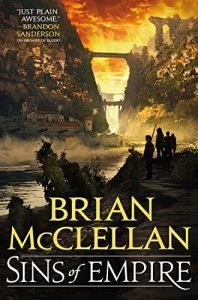 Vlora, general of the Riflejacks mercenary company is mopping up Palo forces on the borders of Fatrasa when she gets a big new contract. A lot of money to travel to Landfall, find one Palo woman, and then some well earned R&R for her and her five thousand men. But all is not what it seems in Landfall.
Vlora, general of the Riflejacks mercenary company is mopping up Palo forces on the borders of Fatrasa when she gets a big new contract. A lot of money to travel to Landfall, find one Palo woman, and then some well earned R&R for her and her five thousand men. But all is not what it seems in Landfall.
Mad Ben Styke, leader of the Mad Lancers, is now a war criminal rotting in a labour camp. He takes the guard’s beatings, he eats the horrible food, and he finds a small sliver of happiness in the little girl Celine who he looks after. Then one day a rich man comes knocking to offer him a way out.
Michel Bravis is a black hat, the secret police force of the vicious and rather terrifying Fidelis Jes. He’s eyeing off a promotion and an opportunity arises—one that could see him pin a gold rose to his chest and join the black hat elite, or see Fidelis Jes run a blade through the same spot.
Sins of Empire is yet another cracking story with a brilliant mix of military action, detective work, and an old school barbarian character. Some old favourite characters from the first trilogy are back and at it again, with old known hurts and actions touched on nicely without beating the reader over the head with it.
The overarching magical danger element and story arc of the trilogy is really nicely set up here, with a familiar enough story to work off as a foundation and plenty of new and interesting magical and world building bits and pieces to sink your teeth in to. And like in all good fantasy epics, you just never know where the next big or small bad is coming from and each new reveal just ramps up your anticipation of what comes next.
My only criticism of the books was the end of one of the character arcs. The build up and expectation was epic, but the delivery, not so much. Fortunately, this is a small part of a magnificent greater whole.
Sins of Empire is everything you expect from a Brian McClellan Powdermage novel—packed with action, relationships that matter, brutal, powerful, and just fun as all hell.
4.5/5
Read Sins of Empire by Brian McClellan
The post REVIEW: Sins of Empire by Brian McClellan appeared first on Grimdark Magazine.
June 4, 2021
REVIEW: Fate of Madness by Jesse Teller
Here we go, the final doorstop of a volume in the massive tetralogy by Jesse Teller, Fate of Madness.
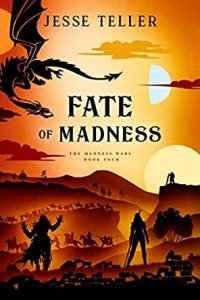 After the first three tomes, Onslaught of Madness, Wrath of Madness, and Plight of Madness, the reader is definitely invested and past the point of backing down. We’re in it to win it, or to be crushed into pulp by the Drine war machine.
After the first three tomes, Onslaught of Madness, Wrath of Madness, and Plight of Madness, the reader is definitely invested and past the point of backing down. We’re in it to win it, or to be crushed into pulp by the Drine war machine.
Rextur is still leading the Drine forces in their conquest of Tienne, but it’s taking too long. And while he’s winning the overall conflict, the boy king Peter Redfist is still a thorn in his side, constantly turning up and sparking little victories here and there, even when he should have been killed long ago. The Madness, as Rextur is also known, is starting to feel that it’s time to push through before the tide turns.
“’Those are Lunatics out there,’ Gralton said. ‘Those are the elite of the elite. The worst, most devastating fighting force known to Drine, maybe the whole world over. If we arm man, woman, and child for them they will cut a swath through that legion of innocence that will bring an ocean of blood to crash upon this place.’”
Part of the problem is that Drine is fighting on two fronts. Besides invading Tienne, they are dealing with an internal struggle for the crown, as the aptly named Treason wages war on his half-brother, the King of Drine. As Rextur is backing his old friend Treason, this splits his assets considerably. Still, he should have enough resources to continue his campaign.
Except, now Tienne has its shit together. While the first wave of conflict had all but wiped out the nobility class of the nation, the survivors of that purge have regrouped, having found the strength within to fight for their country, and survival. Heroes of legend have returned from myth and the new powers of the land are aligning.
Cypress Qirk is solidifying her alliance between the people of the Forest and her betrothed, William of Prox. They have the men of Stonage at their backs and the First King Clark has returned to reclaim his realm.
Tarana is still maneuvering, and is poised to be joined to the First King, realizing her long dream of being Queen of Tienne. Except, it’s not shaping up to be as grand as she’d imagined. The road to her throne is difficult, to say the least. Let’s just remember that she’s been a horrible person to those around her, and things have a tendency to come back around. This is grimdark, we’re talking about.
Aaron the Marked is still leading Peter’s forces in battle, part of the four-pronged thorn in Rextur’s side. The Madness sends his most horrifying warriors after Aaron, and the boy just laughs at them.
Gale Summerstone is also part of a foursome aligned against Rextur, this one a cadre of mages. They bring new skills to the conflict, fresh young powers matched up and holding their own with the Legends of Old.
Saykobar is still moving his pieces on the board as well, this one a mage for the other side. Or is he? While he seems to be aligned with Rextur, when he’s sent to assist Treason he hatches his own agenda. Or is it the agenda of the Valkyrie he serves?
Finally, there is another aptly named protagonist, Revenge. She’s one of three sisters of Treason, and we’ll just say that they take sibling rivalry to a new level. She has been plotting the demise of her half-brother, and it seems like just about every damn one else while she’s at it.
“He smiled and Saykobar realized he had never seen that expression on the Madness before. It was a dark thing poised on a dark face that meant only darkness.”
Fate of Madness brings all of the threads together, and though there are a lot of moving parts, it all starts to make sense by the end. Well, alright. Not so much sense as it gives a feeling of completion. The story arc has concluded, at any rate. Will there be more from the seeds that were planted and the blood that was spilled? Of that, I have no doubt.
Read Fate of Madness by Jesse Teller
The post REVIEW: Fate of Madness by Jesse Teller appeared first on Grimdark Magazine.
June 3, 2021
REVIEW: Wolf of Wessex by Matthew Harffy
In The Wolf Of Wessex, Matthew Harffy picks up a theme which has worked well in other genres and applies it to Dark Ages England. The theme I’m referring to is that of the aged, world-weary warrior, who is somehow persuaded to help a much younger character, often a child.
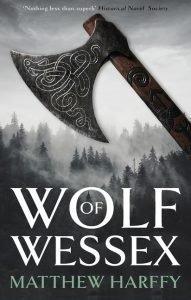 Top of my head, I can remember watching this kind of story unfolding to great effect in the movie True Grit, in which old hand ‘Rooster’ Cogburn, played by Jeff Bridges, agrees to help the younger Mattie Ross track down her father’s killers. Come to think of it, I don’t recall previously coming across this kind of story in historical fiction. But Harffy reapplies this theme to great effect after he kicks off the book with a cracker of an opening line, which instantly sets a dark, mysterious tone to proceedings:
Top of my head, I can remember watching this kind of story unfolding to great effect in the movie True Grit, in which old hand ‘Rooster’ Cogburn, played by Jeff Bridges, agrees to help the younger Mattie Ross track down her father’s killers. Come to think of it, I don’t recall previously coming across this kind of story in historical fiction. But Harffy reapplies this theme to great effect after he kicks off the book with a cracker of an opening line, which instantly sets a dark, mysterious tone to proceedings:
‘It had been a good morning until Dunston found the corpse’
Therein also lies an immediate introduction to the novel’s protagonist, Dunston. All we know at the start of the book is that Dunston is an old warrior. He’s also one who lives like a hermit alongside the woods with his one-eyed dog Odin. Personally speaking, I found it easy to identify with a character who is tired of the world and has chosen to turn his back on it. Yet following the discovery of the corpse, Dunston and Odin also come across the dead man’s daughter Aedwen, hiding away in the forest. The old warrior is left with no choice but to take her under his wing. This also means that he must eventually also mingle again with other people. Which is something that Dunston doesn’t find easy:
“At times, when the winter wind bit the skin, and food was scarce; when the nights were long and the days short and brittle with ice and snow, Dunston would ask himself if he had chosen the right path for his life. Wouldn’t he have been better off finding a new wife to tend to his needs? At moments like that he yearned for the company of others. Now, listening to Ceolwald’s inane and incessant chatter, he was sure he had chosen wisely when he had made his home amongst the trees of Sealhwudu”
Paragraphs like this are great at highlighting Dunston’s independent spirit. Before long he finds himself having to heavily rely on this quality, when the authorities who should assist him and Aedwen instead turn on them both. In a stunning turn of events, Dunston and Aedwen are forced to form an unlikely pairing. Together they engage in a desperate struggle to evade unjust accusations and punishments, while also trying to find out the true cause behind the horrific murder of Aedwen’s father.
Harffy creates some nasty, dangerous antagonists who add a lot of tension to this well-crafted and well-researched tale. Dunston also has to contend with his old, creaking body, so that the reader is often left asking: does the once great warrior still have what it takes to overcome his greatest challenge yet? In this respect, there are echoes of Gemmell’s Druss in Dunston. But both the character’s traits and his background are well crafted by Harffy, so that the old wolf is an original creation that is very engaging. Aedwen is also well developed, and the relationship between the two makes for some touching and heart-warming stuff, without ever being soppy. My reading was also enhanced by the author’s great command of language, which is both evocative and stirring. All of which contributes to a tense finish that will keep the reader glued to the pages.
This is the second book I’ve read by Matthew Harffy, and it’s great to once again witness him breathing so much life and suspense into the historical adventure genre. Wolf Of Wessex is a five on five star read. It possesses a great story arc, interesting characters and a highly satisfying conclusion.
Read Wolf of Wessex by Matthew Harffy
The post REVIEW: Wolf of Wessex by Matthew Harffy appeared first on Grimdark Magazine.

